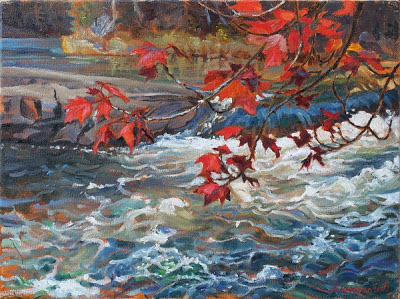Another batch of slug watercolours
Deroceras reticulatum
I have just finished the third dorsal view of this ubiquitous slug introduced from Europe, Deroceras reticulatum, the milky-slimed muncher in every garden, variable in colour and fast moving. You can see the flat spot in the rear portion of its mantle, where the vestigial shell sits, internally. The finger-print wrinkles are slighter just over this bit of shell that reminds us that slugs are relatives of snails. It has two characteristics that make it easy to tell apart from its native cousin D. laeve. D. reticulatum has a large pale area surrounding its pneumostome, or breathing hole, and when the animal is touched, it exudes exceedingly sticky white mucous which is hard to get off your hands, and can cause dermatitis in the slug collector.
The lateral view and first dorsal view were painted from a 45mm individual collected by Judy Courteau, from under an Elm tree near Dunville, Ontario, on 23 September. The second dorsal view was collected by Fred, from under the "Novisuccinia board" here in Bishops Mills, field number 2008/279/db, and the third dorsal view (the pale one) was collected by Judy in the spring, from a greenhouse in Smiths Falls.
Deroceras laeve
is native, a feisty little slug. It moves even faster than D. reticulatum, having a very narrow foot on which it practically runs about, sometimes chasing other slugs and biting their tails. It is more or less dark brown with chestnut mottling, especially on the mantle, which is boldly wrinkled - but from above and without magnification, it appears black. When disturbed, it exudes a clear mucous which seems to fill in all the wrinkles and make its body appear smooth and shiny. The pneumostome is not as noticeably pale as it is in D. reticulatum. The individual I painted here is 28mm from head to tail, and was collected by Judy Courteau on 17 September at Highway 90, east of Angus, Ontario.
Pallifera dorsalis
is a tiny native slug of forests east of the prairies. On close inspection it is unmistakeable, having a smooth (very slightly wrinkled) gray mantle covering its entire body, from head to tail. The eye stalks are darker, and the front of the foot, near the mouth, is rusty coloured. This individual, 12mm from head to tail, was bluish-gray when it was taken into captivity at Little Cove on the Bruce Penninsula, by Matt Keevil. For the first week it did not stray from the little piece of moss that it had been collected with, avoiding the scrap of Romaine lettuce that is the fare of all of our captive slugs. But after a week or so it began to eat the lettuce, and by the time I got around to painting it, its body colour had changed from blue gray to more of an olive gray. I made a compromise and painted it somewhere in between.
Arion intermedius
is another small slug, delicate, yellowish with tints of blue, a yellow foot, faint lateral stripes, and black eye stalks which give it the classy aspect of a siamese cat. Along with the other Arion slugs, it is an European immigrant. The few individuals that we caught on our trip in August of this year (at least two localities) are the first slugs of this species recorded in Ontario outside of greenhouses. They may have been "naturalized" for decades, but being easily overlooked, and since the landscape was not crawling with malacologists, they were not reported until we discovered them. Robert sent me one from British Columbia (where they live along the coast) earlier in the summer, but it must have either perished or been eaten by one of the larger slugs, because I searched through its box in vain. I was very happy to have this one to paint, 25 mm in length, and collected near the Durham Conservation Centre, West Grey, Grey County, Ontario. As I painted its portrait, I delighted in its unique aspect and charming habits - one of which was to curl up like a cat, head to tail, to have a nap. When disturbed, it assumed a classic Arion hump-shape, which I have also painted here.
Arion distinctus
This slug we suspected is Arion hortensis because of its orange foot, placement of lateral stripes, and dark colour. Robert decided that it is Arion distinctus, in the A. hortensis species group. It is 40 mm long, which is the maximum length of the species, according to the European Land Snails book. It was collected by Judy Courteau from a greenhouse on River Road in Ottawa, another European introduction. Like Arion intermedius, it also curls up like a cat, head-to-tail, to sleep between meals. It hollowed out the yellow snap bean, favours the green ones less well, but avoids Romaine lettuce, which is a favorite of most of our molluscan guests.
Arion fasciatus
from Coburg, Ontario, is 50mm long from tiny dark head to the tail at the end of its exceedingly extensible body. When it was crawling fast, it just got longer and thinner like an earthworm, at least 15mm longer than the position in which I have portrayed it. The yellow tint below its lateral lines is a diagnostic feature, as is the pale yellow foot.



Comments
Post a Comment
What do you think of this painting, and what do you know about the subject that I have painted?